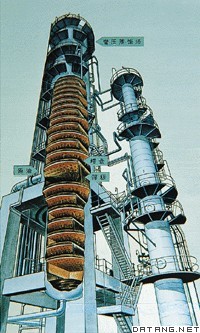1) permeation flux
蒸馏通量
2) flux of membrane distillation
膜蒸馏通量
3) distillation
蒸馏
1.
Ethanol recovery from auto-catalyzed ethanol pulping of aspen by distillation;
蒸馏回收杨木自催化乙醇法蒸煮废液中乙醇溶液
2.
Treatment of waste water from reaction vessel scrubbing of maleic anhydride production through distillation and neutralization;
利用蒸馏与中和方式处理顺酐洗锅废水
3.
Study on the distillation and distillate of cashew nut shell liquid;
腰果壳油的蒸馏及馏分成分研究
4) distill
蒸馏
1.
There are two kinds of alcohol drink,distilled alcohol liquor and fermented alcohol drink.
根据蒸馏酒理论采用微积分方法,以酒精质量分数与相对密度的对照表以及蒸馏时原酒液质量分数与蒸馏液质量分数对照表两组基础数据为依据,推导了原酒液酒度随蒸馏体积分数变化的关系方程式,进一步推导了以低度酒为原料进行蒸馏的蒸馏液酒度随蒸馏液体积变化的方程式,该方程可用于蒸馏过程酒度控制。
2.
The thesis analyzes the prerequisite for distilling separation and discusses the distinction between volatility of the components under mixed state and volatile ability of pure ones.
本文分析了蒸馏分离的前提条件 ,着重讨论了混合态时组分的挥发性与纯组分挥发能力的区别 ,指出蒸馏操作能够进行的前提条件及正确判别蒸馏分离难易程度的方
3.
Based on the theory and combining with low temperature distillation technology,a device for recuprating exhaust heat of vessal engine is simulated and designed so that the seawater can be desalinizated.
通过对发动机尾气热值的理论计算,模拟设计利用船舶发动机尾气余热并结合低压多级闪蒸法蒸馏淡化海水装置及其推广应用。
5) rectification
蒸馏
1.
According to the grand composite curve of the process system,more optimization plans are proposed,especially absorption refrigeration system driven by low grade vapor of rectification tower is designed to produce cooling water w.
以酒精蒸馏较先进的五塔蒸馏工艺流程为研究对象, 运用夹点技术对系统进行用能诊断和调优, 分析现有系统的用能状况, 指明了不合理的换热器设置及改进后的节能效果, 根据过程总复合曲线进一步提出调优方案, 利用工艺过程的二次蒸气制取酒精生产全过程所需的17℃左右低温冷却水, 实现了节能、节水与环保多重效益, 显著降低了酒精生产成本。
2.
According to the rectification coefficient (k) of the isoamyl alcohol,it is suitable for the fusel oil to be extracted in the layer of 42%(v/v) alcohol concentration in the rectification column.
由异戊醇的精馏系数(k′)理解,在酒精蒸馏过程中,从精馏塔酒精浓度42%(v/v)处提杂醇油最适宜。
6) vacuum distillation
真空蒸馏
1.
Industrial experiment on recovering metals from waste zinc-tin alloy by vacuum distillation;
真空蒸馏法从废杂锌锡合金中回收金属的工业试验
2.
Cadmium recovery process and modeling in the Ni-Cd batteries by vacuum distillation;
真空蒸馏回收镍镉电池中镉金属工艺优化模型研究
3.
Purification of γ-irradiated 30 % TRPO-ke rosene by vacuum distillation;
真空蒸馏净化辐照后的TRPO煤油体系
参考词条
补充资料:蒸馏
| 蒸馏 distillation 利用液体混合物中各组分挥发度的差别,使液体混合物 部分汽化并随之使蒸气部分冷凝,从而实现其所含组分的分离。是一种属于传质分离的单元操作。广泛应用于炼油、化工、轻工等领域。 其原理以分离双组分混合液为例。将料液加热使它部分汽化,易挥发组分在蒸气中得到增浓,难挥发组分在剩余液中也得到增浓,这在一定程度上实现了两组分的分离。两组分的挥发能力相差越大,则上述的增浓程度也越大。在工业精馏设备中,使部分汽化的液相与部分冷凝的汽相直接接触,以进行汽液相际传质,结果是汽相中的难挥发组分部分转入液相,液相中的易挥发组分部分转入汽相,也即同时实现了液相的部分汽化和汽相的部分冷凝。 工业蒸馏的方法有:①闪急蒸馏。将液体混合物加热后经受一次部分汽化的分离操作。②简单蒸馏。使混合液逐渐汽化并使蒸气及时冷凝以分段收集的分离操作。③精馏。借助回流来实现高纯度和高回收率的分离操作 ,应用最广泛。对于各组分挥发度相等或相近的混合液,为了增加各组分间的相对挥发度,可以在精馏分离时添加溶剂或盐类,这类分离操作称为特殊蒸馏,其中包括恒沸精馏、萃取精馏和加盐精馏;还有在精馏时混合液各组分之间发生化学反应的,称为反应精馏。
|
说明:补充资料仅用于学习参考,请勿用于其它任何用途。
